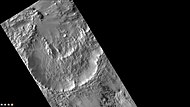McMurdo (crater)
Close-up of Layers in wall of McMurdo, as seen by HiRISE. | |
| Planet | Mars |
|---|---|
| Coordinates | 84°24′S 359°06′W / 84.4°S 359.1°W |
| Quadrangle | Mare Australe |
| Eponym | McMurdo Station, Antarctica |
McMurdo is a crater in the Mare Australe quadrangle of Mars, located at 84.4° S and 359.1° W. It is 30.3 km in diameter and was named after McMurdo Station in Antarctica.[1]
Many layers are visible in the south wall of the crater. Many places on Mars show rocks arranged in layers. The study of layering on Mars greatly expanded when the Mars Global Surveyor sent back images.[2][3] Rock can form layers in a variety of ways. Volcanoes, wind, or water can produce layers.[4][5][6] A detailed discussion of layering with many Martian examples can be found in Sedimentary Geology of Mars.[7] A paper by Grotzinger and Milliken discusses the role of water and wind in forming layers of sedimentary rocks.[8]
Just to the south of McMurdo is a field of numerous short, dark streaks or fans. These are caused by the outgassing of carbon dioxide in the spring when the temperature is rising. The carbon dioxide gas carries with it dark particles. If a wind is blowing at the time, the plume of material is spread to one side forming a streak or a fan; these features have been called spiders because at times they look like spiders with many legs.[9][10][11][12][13][14][15] Both layers and fans are shown in the pictures below.
-
McMurdo, as seen by CTX camera (on Mars Reconnaissance Orbiter).
-
Short dark streaks are dark fans caused by outgassing of carbon dioxide and dark material. Layers are easily visible in the wall of the crater. Note: this is an enlargement of the previous image of McMurdo. Picture taken with CTX camera (on Mars Reconnaissance Orbiter).
See also
[edit]- Geology of Mars
- Geyser (Mars)
- HiRISE
- Impact crater
- Impact event
- List of craters on Mars
- Ore resources on Mars
- Planetary nomenclature
References
[edit]- ^ "McMurdo (crater)". Gazetteer of Planetary Nomenclature. USGS Astrogeology Research Program.
- ^ "Archived copy" (PDF). Archived from the original (PDF) on 2016-09-28. Retrieved 2017-08-17.
{{cite web}}: CS1 maint: archived copy as title (link) - ^ Malin, M. C., & Edgett, K. S. (2000). Sedimentary Rocks of Early Mars. Science, 290(5498), 1927–1937
- ^ NASA.gov
- ^ NASA.gov
- ^ "HiRISE | High Resolution Imaging Science Experiment". Hirise.lpl.arizona.edu?psp_008437_1750. Retrieved 2012-08-04.
- ^ Grotzinger, J. and R. Milliken (eds.). 2012. Sedimentary Geology of Mars. SEPM.
- ^ Grotzinger, J.P. and R.E. Milliken (2012). The sedimentary rock record of Mars: Distribution, origins, and global stratigraphy, SEPM Special Publication, 102, 1-48.
- ^ Manrubia, S. C.; O. Prieto Ballesteros; C. González Kessler; D. Fernández Remolar; C. Córdoba-Jabonero; F. Selsis; S. Bérczi; T. Gánti; A. Horváth; A. Sik; E. Szathmáry (2004). "Comparative Analysis of Geological Features and Seasonal Processes in Inca City and PittyUSA Patera Regions on Mars" (PDF). European Space Agency Publications (ESA SP): 545. Archived from the original (PDF) on 2011-07-21.
- ^ Kieffer, H. H. (2000). "Mars Polar Science 2000 - Annual Punctuated CO2 Slab-ice and Jets on Mars" (PDF). Retrieved 6 September 2009.
{{cite journal}}: Cite journal requires|journal=(help) - ^ Kieffer, Hugh H. (2003). "Third Mars Polar Science Conference (2003)- Behavior of Solid CO" (PDF). Retrieved 6 September 2009.
{{cite journal}}: Cite journal requires|journal=(help) - ^ Portyankina, G., ed. (2006). "Fourth Mars Polar Science Conference - Simulations of Geyser-Type Eruptions in Cryptic Region of Martian South" (PDF). Retrieved 11 August 2009.
{{cite journal}}: Cite journal requires|journal=(help) - ^ Sz. Bérczi; et al., eds. (2004). "Lunar and Planetary Science XXXV (2004) - Stratigraphy of Special Layers – Transient Ones on Permeable Ones: Examples" (PDF). Retrieved 12 August 2009.
{{cite journal}}: Cite journal requires|journal=(help) - ^ "NASA Findings Suggest Jets Bursting From Martian Ice Cap". Jet Propulsion Laboratory. NASA. 16 August 2006. Retrieved 11 August 2009.
- ^ C.J. Hansen; N. Thomas; G. Portyankina; A. McEwen; T. Becker; S. Byrne; K. Herkenhoff; H. Kieffer; M. Mellon (2010). "HiRISE observations of gas sublimation-driven activity in Mars' southern polar regions: I. Erosion of the surface" (PDF). Icarus. 205 (1): 283–295. Bibcode:2010Icar..205..283H. doi:10.1016/j.icarus.2009.07.021. Retrieved 26 July 2010.

